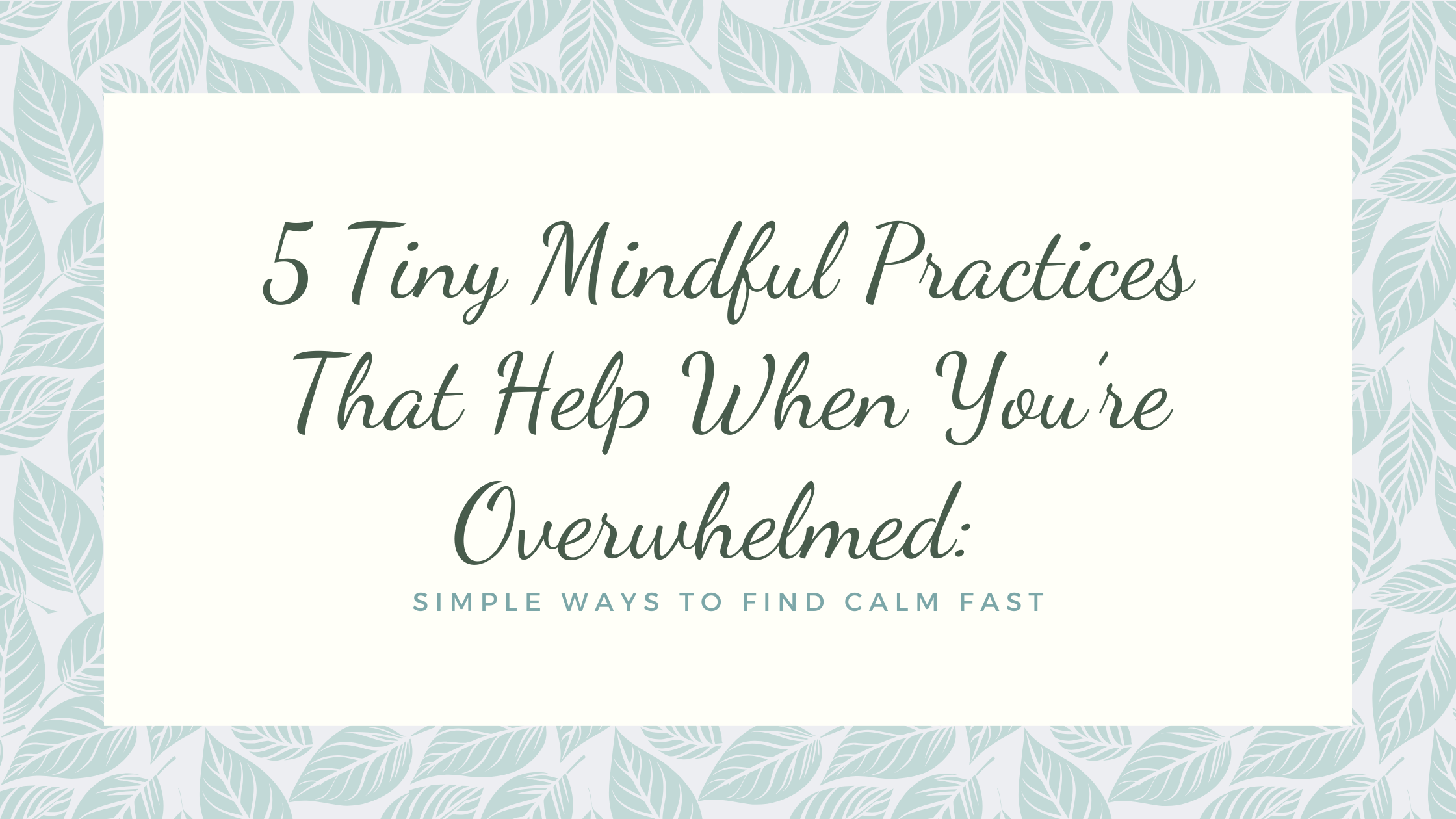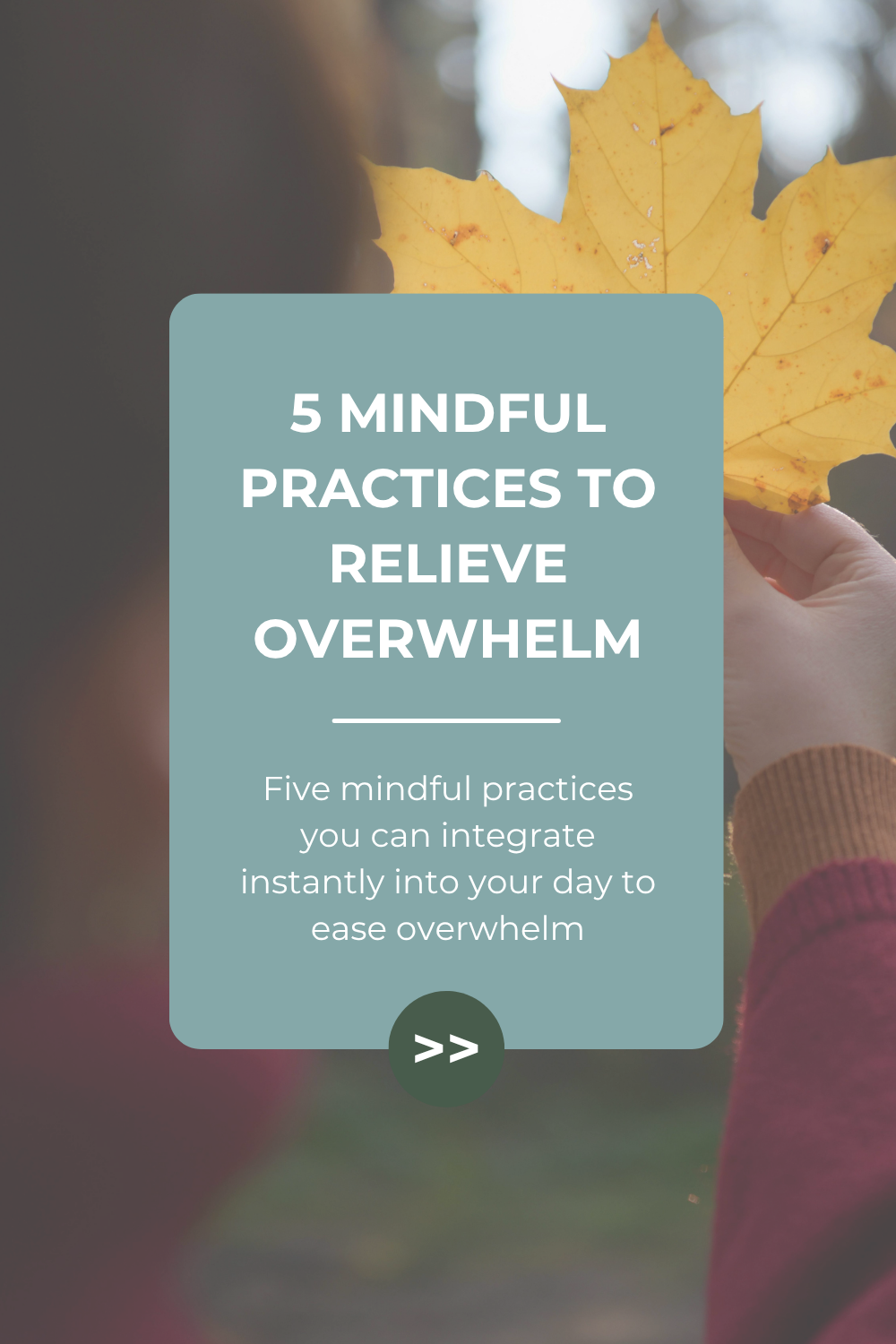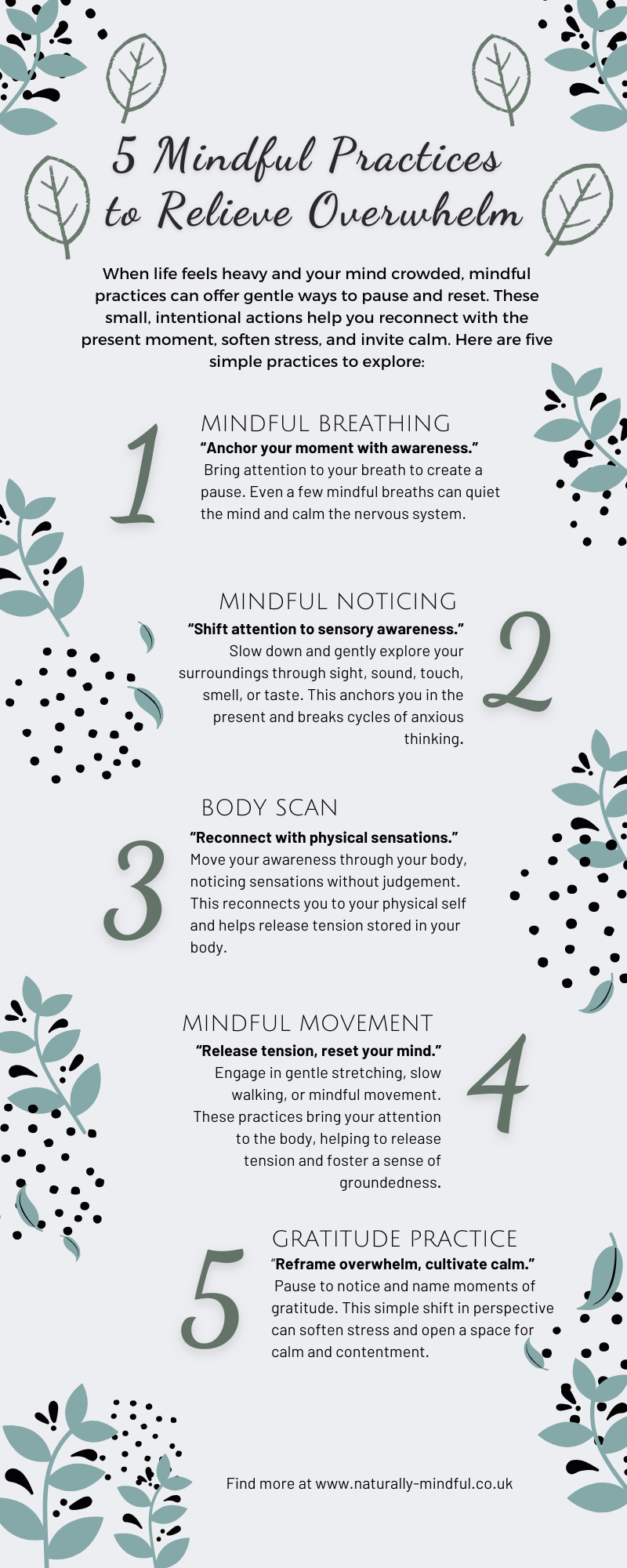5 Tiny Mindful Practices That Help When You’re Overwhelmed: Simple Ways to Find Calm Fast
Finding Calm in the Midst of Overwhelm
At some point, we all feel overwhelmed… a mounting to-do list, emotional pressure, or the weight of life itself. Overwhelm isn’t just a passing feeling; it can affect our mental wellbeing, physical health, and relationships.
Mindfulness offers a gentle, practical way to respond to overwhelm. Instead of pushing through or trying to fix everything, mindfulness teaches us to pause, notice, and respond with awareness. This article explores 5 tiny mindful practices that help when you’re overwhelmed; tools you can use in minutes to reconnect with calm and clarity.
Whether you are looking for quick stress relief or a way to build long-term resilience, these simple practices are designed for everyday life.
Understanding Overwhelm and Mindfulness
Overwhelm is a state where the demands on our mind, body, or emotions exceed what we can comfortably manage. It’s more than feeling stressed, it’s a deeper sense of being flooded, where the weight of everything around us feels too heavy to hold. Overwhelm can arise from many sources: constant work pressure, personal life challenges, emotional triggers from past experiences, or simply an overload of sensory input such as noise, screens, and information.
When our nervous system feels overstimulated, it struggles to find calm. This can leave us feeling mentally, physically, and emotionally depleted. Overwhelm is not a weakness, it’s a signal from your body and mind telling you that you need a pause and a recalibration.
Common signs and symptoms of overwhelm include:
Racing thoughts - when your mind feels like it’s on constant loop, unable to focus or rest.
Feeling drained or anxious - low energy paired with a constant sense of tension.
Difficulty making decisions - even simple choices can feel exhausting or impossible.
Emotional reactivity - quickness to frustration, sadness, or irritability.
Recognising overwhelm early is important. It gives you the chance to step back before exhaustion becomes burnout. By understanding its root causes, whether external pressures, emotional patterns, or physical exhaustion, you can begin to respond in ways that truly support your wellbeing rather than adding to the cycle of overwhelm.
External resource: For a deeper dive into the science of stress, see NHS — Stress management.
How Mindfulness Helps Relieve Overwhelm
Mindfulness is the practice of paying attention, intentionally, to the present moment without judgement. It is about gently anchoring yourself in what is happening right now, rather than being lost in thoughts about the past or worries about the future. This simple yet powerful approach can transform how we respond to overwhelm.
When we practise mindfulness, we create space between ourselves and the flood of thoughts, feelings, and demands. This space allows us to notice what is happening without being swept away by it, helping us respond rather than react. Over time, mindfulness builds resilience and offers profound benefits for moments of overwhelm, including:
Reducing stress and anxiety - by calming the nervous system and easing mental tension.
Improving emotional regulation - enabling a steadier response instead of impulsive reactions.
Enhancing clarity and focus - helping the mind settle so we can see choices more clearly.
Encouraging self-compassion - fostering a gentler inner voice rather than self-criticism.
One of the most beautiful things about mindfulness is that it doesn’t require hours of formal meditation or elaborate routines. Even tiny, intentional practices woven into daily life can shift your state of mind. Pausing to take a breath before answering a message, noticing the sensation of your feet on the ground, or simply paying attention to the sound of your breath are small yet powerful ways to reclaim calm in moments of overwhelm.
Mindfulness becomes not just a technique, but a way of being, a gentle invitation to slow down and return to yourself, even when life feels fast and heavy.
5 Tiny Mindful Practices to Try
Here are five mindful practices you can integrate instantly into your day to ease overwhelm.
1. Mindful Breathing to Anchor Your Moment
Breathing is something we do automatically, but bringing mindful awareness to your breath can instantly help calm your nervous system and bring you back to the present moment. It is a simple yet powerful tool you can use anywhere, at your desk, in a busy café, or even in the middle of a stressful conversation.
How to do it:
Pause and take a deep breath in through your nose for four seconds, noticing the air filling your lungs.
Hold the breath gently for seven seconds, allowing yourself to rest in stillness.
Exhale slowly through your mouth for eight seconds, letting go of tension with the breath.
Repeat this cycle three to five times, or for as long as feels helpful.
Why it works: Mindful breathing engages the parasympathetic nervous system, signalling your body to slow down and switch from a state of stress to one of relaxation. It lowers heart rate, eases muscle tension, and quiets racing thoughts. Over time, regular mindful breathing can strengthen your ability to regulate emotions and restore clarity during overwhelming moments.
Think of mindful breathing as an anchor: a simple practice that helps ground you wherever you are. Even a single breath taken with intention can create a pause big enough to shift your state of mind.
2. Notice Something Beautiful Around You
Mindful noticing shifts your attention from mental overload to sensory awareness, which can instantly ground you and create a sense of calm in the midst of overwhelm. It’s a practice that brings you out of your head and back into the present moment, helping you reconnect with your surroundings in a meaningful way.
How to do it:
Pause for a moment and look around you without rushing.
Pick one detail that catches your attention, the texture of leaves, the way sunlight rests on a window, a distant sound, or a subtle scent in the air.
Spend at least 30 seconds fully noticing it: observe its qualities, colours, patterns, or sensations without judgment.
Allow yourself to stay with this detail for as long as it feels nourishing.
Why it works: This simple practice anchors you in the present moment, gently breaking cycles of anxious thinking and mental overwhelm. It invites a shift from reactive thinking to mindful awareness, giving your mind a pause to rest and reset.
In my own practice, mindful noticing has become a quiet form of self-care. When my mind feels like a storm, even noticing a single feather drifting in the wind or the subtle scent of earth after rain can bring a surprising sense of calm. It reminds me that presence is often found in the smallest details.
Further Reading:
10 Mindfulness in Nature Activities You Can Try Today
This checklist offers various activities to practice mindfulness in nature.
Nature-Based Mindfulness Activities for Families
Engage families in mindfulness practices through nature-based activities.
What We Can Learn About Well-Being from Nature
Delve into the lessons nature teaches us about well-being.
3. One-Minute Body Scan
A quick body scan reconnects you to your physical sensations and helps release tension stored in the body. It acts as a gentle check-in, allowing you to notice where stress might be held and offering a way to bring yourself back to a grounded, balanced state.
How to do it:
Sit or stand in a position that feels comfortable and supported.
Close your eyes if you feel safe doing so, allowing your attention to turn inward.
Begin by bringing awareness to your feet, noticing any sensations such as warmth, coolness, pressure, or tingling.
Slowly move your attention upward through your body: your ankles, calves, knees, thighs, hips, abdomen, chest, shoulders, arms, hands, neck, and finally your head.
At each stage, notice sensations without judgement, simply observing whatever is present.
Finish by resting your attention on your breath, letting your body soften with each exhale.
Why it works: A body scan shifts your focus away from overwhelming thoughts and brings attention back into your physical body, helping you reconnect with the present moment. This awareness releases tension, calms the nervous system, and creates a deeper sense of balance and ease.
In moments of overwhelm, a body scan can feel like a quiet pause; a way to step out of the rush and reconnect with yourself, even if only for a few breaths.
4. Gentle Movement or Stretching
Movement can release tension held in the body and gently shift your mental state. Mindful movement deepens the connection between body and mind, offering a simple yet powerful way to step out of overwhelm and into presence.
How to do it:
Begin with small, slow stretches, perhaps your shoulders, neck, or back, paying attention to how each muscle feels as you move. Notice sensations like warmth, tingling, or release without judging them as good or bad.
Try mindful walking: move slowly, paying close attention to each step. Notice the shifting weight in your feet, the rhythm of your breath, and the feel of the ground beneath you.
You might add gentle stretching or flowing movement, such as raising your arms overhead or rolling your shoulders, allowing each motion to be intentional and unhurried.
Why it works: Movement increases body awareness, encourages the release of physical and emotional tension, and offers your nervous system a reset. When you move mindfully, you invite calm, slow your breath, and strengthen the connection between mind and body.
For me, even a few mindful steps outside, feeling the earth underfoot, can transform a moment of overwhelm into a moment of presence.
Further Reading
Mindful Mornings: Starting Your Day with Movement and Self-Care
This article offers insights into beginning your day with mindful movement and self-care.
Embracing Mindful Movement: A Guide to Boosting Mental Health
Explore the benefits of mindful movement and how it can enhance mental health.
5. Gratitude Pause
A short gratitude practice can gently reframe overwhelm, helping you shift your focus away from stress and cultivate a sense of inner calm. Gratitude is a subtle but powerful tool for transforming perspective, even in the midst of a busy or challenging day.
How to do it:
Close your eyes and take a few slow, deep breaths, letting your shoulders soften with each exhale.
Bring your attention inward and name three things you are grateful for in this moment, they can be big or small: a warm cup of tea, a kind word from a friend, the sound of birds outside.
Allow yourself to truly feel the gratitude, noticing how it feels in your body, perhaps a softening in the chest or a lightness in your breath.
Carry this sense of gratitude with you as you return to your day.
Why it works: Gratitude helps reframe your perspective, moving attention away from stress or overwhelm. It creates space for calm and builds emotional resilience. Even a brief moment of gratitude can shift your state of mind and encourage a greater sense of presence.
In my own experience, even naming one small thing I’m grateful for can create a surprising ripple of peace, helping me reconnect to what matters most.
Tips for Integrating Mindful Practices into Your Day
These micro-practices work best when woven naturally into daily life rather than treated as another task to tick off your list. The real power lies in making them a gentle part of your rhythm rather than an obligation.
Start small: Choose one practice that feels easy and approachable, and begin there. Notice how even a few mindful breaths or a short body scan can subtly shift your mood and the flow of your day. There’s no need to rush, the aim is consistency, not perfection.
Use reminders: Life moves fast, so gentle prompts can help bring you back to the present. Place visual cues where you’ll see them often, a sticky note on your desk, a mindful image on your phone, or a calming object in your bag. You could also set phone reminders at times when overwhelm tends to creep in. These cues become little invitations to pause, breathe, and reset.
Make it a ritual: Anchor your mindful practices around everyday moments so they become woven into your life. This could be after your morning coffee, before a meeting, while waiting for a kettle to boil, or on your daily commute. Over time, these moments become soft touchstones in your day, offering a sense of steadiness and presence even in busy or stressful times.
When mindful practices feel integrated rather than imposed, they become part of your life’s fabric, small acts that add up to a lasting shift in how you move through the world.
Further Reading:
📱 Mindfulness Tools & Resources
Unlocking Inner Peace: Top Mindfulness Apps for Mental Wellness
Discover mindfulness apps that can aid in mental wellness.Explore the Best Mindfulness Apps for Your Smartphone
A comprehensive guide to mindfulness apps, offering features and recommendations.
FAQs
What are the best mindfulness practices for anxiety?
Mindful breathing, body scans, and gratitude pauses are particularly effective for calming anxiety.
How can mindfulness help with overwhelm?
Mindfulness slows the mental chatter, allowing clarity and emotional regulation.
What is a mindful practice and how do I start?
A mindful practice is a simple act of bringing focused attention to the present moment. Start with short, daily exercises such as mindful breathing or noticing your surroundings.
How long does mindfulness take to work?
Even a minute of mindful breathing can offer relief. Regular practice builds long-term resilience.
Can mindfulness really reduce stress?
Yes, research shows mindfulness lowers cortisol levels and improves emotional wellbeing.
Overwhelm doesn’t need to take over your life. By practising these tiny mindful exercises, you can build calm, clarity, and resilience, one breath, one moment at a time.
If you want to explore mindfulness more deeply, download my Free Mini Mindfulness Resources and start your journey today.



